So what exactly is a session beer? Well, depending on who you are talking to you will get a range of answers. Some argue BJCP style guidelines and state that a session beer is either an English styled Mild or Bitter because the term session beer likely originated there. Some debate that it goes further than this argument and define the style in terms of alcohol content. Some may include Light mass produced American lagers in this category while others may not. What they do I think of as a session beer? I believe it can be just about any style and I personally fall more into the category that argues ABV% as the defining factor. So in my definition a Michelob Ultra would technically fall under the “definition” but that still doesn’t mean its any good. In the end though it doesn’t really matter how you define it as long as you know what you are looking for and this post is more about generic guidelines to follow regardless of the style. After doing some reading I picked out a few general tips following recipe formation from grain selection to mashing to hops to yeast to cold side fermentation. But before we start, here are a few things I looked at: http://www.byo.com/stories/beer-styles/article/indices/11-beer-styles/2344-session-beers-techniqueshttp://redwoodcoastbrewers.org/treatise_on_session_beers.htmlhttp://beersmith.com/blog/2011/09/15/session-beer-with-the-mad-fermentationist-beersmith-podcast-22/Grain: The goal here (in my opinion) is to get a lot of flavor out of the small amount of grain you are using so character malts are essential. Special Roast, aromatic, biscuit, crystal, honey and Munich malts are all great for adding additional body and flavor but they must be used in moderation. Other good options include Vienna or lighter Munichs, Carafa, lighter Crystal, or small amounts of roasted barley. While sugar is often cited in English Bitters it brings down FG, raises the alcohol content and provides no flavor so it doesn’t seem necessary unless those are your goals. In the end it comes down to balance and because your overall poundage of grain is significantly lower than a “normal”beer, ¼ lb or even just 1-2 ounces of specialty malts can make a difference. Mash: With the end goal being a low alcohol brew with flavor and body you can safely mash higher than normal. Achieving a more dextrinous wort will leave a higher final gravity and more unfermentable sugar behind which will aid in body and flavor. However, this is why balance of character malts is important. While you want body and flavor an excessive amount of crystal malt can easily overrun your beer and throw it out of balance. Watching the percentages as opposed to the total weight can help prevent this. Other options for mashing which should be mentioned include the full volume mash and the decoction mash. Using full volume without a sparge has been argued to increase flavor and body by some and cuts a step out of your brewday. Decoction mashing does the opposite by adding a lot of work to your brewday while debatably altering your beer in ways that cannot be achieved through grain additions and normal mashing but this is not the time or place to discuss the merits of a decoction mash. Another option is boiling down the first runnings in a separate kettle to achieve some kettle caramelization which deepens the color and the flavor of the wort but may not be appropriate of all styles. These are a few things to consider but none are ever necessary. Hops: Hopping a session beer is a fine line but the main goal is balance while achieving flavor. Hops are tricky because levels of flavor and aroma are determined by style but staying within the bitterness ratio of a given style is a good guide. If flavor and aroma is needed hops with lower alpha acids toward the end of the boil are easier to work with on a small scale than higher alpha acid hops. Ignoring a traditional bittering hop addition at 60 minutes and hopbursting (continuously hopping from 15-0 minutes) can help reach your desired IBUs while achieving an intense flavor and aroma. Dry hopping of course is another option which aids in flavor and aroma. Yeast: Again, this is a bit of personal preference but there are a few things to consider. First is flavor. Are you looking for the yeast to have an impact or simply to cleanly ferment the beer leaving the malt and hops to shine through? Second is attenuation. If you’re seeking that higher final gravity Safale US-05 may not be the way to go. Instead, less aggressive yeast strains with lower expected attenuation are available. Cold Side Fermentation: These steps aren’t really any different than any other beer but with a smaller and simpler beer off flavors have less to hide behind. So, in short: ferment at a stable temp, pitch proper amounts of healthy yeast, be extra crazy about cleaning and sanitizing and properly aerate your beer. Cold conditioning can also achieve a solid and drinkable product but isn’t always necessary.
That’s right; I used a Something about Mary reference fourteen years later in the title because lately I’ve been digging on the lighter side of brewing. And no, I’m not talking about Bud Light clones. Although, don’t hate me, that is my go to crappy light beer choice when push comes to shove. No, I’m talking about a nice session beer. But in a homebrewing/craft beer world dominated by insanely hopped India Pale Ales, deadly dark Russian Imperial Stouts and other random genre blending, imperializing, oaked, soured, wet hopped, Belgianized brews where does the simple session beer fit in? Well, let me tell you.
First off, they fit in whenever you don’t want to get annihilated off drinking three beers. Don't get me wrong, I love a nice big beer as much as the next guy, but as much as the craft beer world seems to work to separate themselves from mainstream American culture they seem to fit right in. Before you explode in anger stroke let me explain. They are the SUVs of beer. They are the Super Sized meal. They are the summer blockbuster. By this of course I mean bigger is better in the craft beer world. Now, of course this is not the golden rule but it’s hard to argue that 6% is not the new 5% and that anything above 7% is not somewhat common. So when you’re in the mood to throw a few back but still need to drive home and work tomorrow the session beer is for you.
(Interesting side note: it seems light (Lite?) beer is the only mainstream thing in America in which bigger is not better. And yes, I realize that my craft brew analogies are not perfect because craft beer is often of higher quality as opposed to the Big Mac or Transformers III: Crap on the Moon but still, they do tend to go big so I think my points stand)
But wait, you may find yourself saying “I like flavor” “I like hops” “I like body”. Well my friend, this brings me to point number two which is the fact that session beers can have all of these. If done right they’re easy on the liver yet tasty on the way down. Low alcohol, low
cost, low calorie (because remember, this is apparently important to the American beer drinker after eating three Big Macs), but still high in flavor. Toss back a great session beer for a truly nice beer that you can enjoy two of.
And finally, point number three, if you like big beer brewing and pounding back good old double digit ABV% beers then session beer brewing can be for you too. But wait, isn’t that kind of the opposite of this whole idea? Well yeah, it can be, but not if you’re talking about the resurrection of the partygyle brew! I’m not going to beat around the bush, I’ve only done this twice and the results were less than perfect (although not bad) but I love the idea. Mash in your monster, drain off the first runnings for the beast and then sparge your way to a nice little guy to enjoy every day. Gives you a longer (and hopefully more rewarding) brewed plus more beer for your
money.
So in short, I love low gravity beers. I’ve been playing around with a few test batches I need to write about, analyze and test out (mostly Milds, Bitters and the low gravity sessionized yet hop forward American Pale Ale) because like most craft beer drinkers and brewers I got caught up in the big beer craze so this is a bit of a foreign concept to me. But I like it! Simplicity plus technique plus knowledge of what ingredients you’re working with equals a good session beer. Or so I think, I guess I’ll need to test that out. My plan is to do some more research on this and do some writing on techniques but until then I think I’ll have twelve of these 3.5% beers and wake up sober.
(Interesting side note number two: I desperately need to do a write up on my one gallon basemalt SMaSH experiments because these are what got me into the whole session beer idea. No they are not fantastically interesting beers, but I love tossing them back on Sunday during the football game without nearly killing myself. So, hopefully in the near future I’ll pop open one each of the Maris Otter, Rahr 2-Row, Munich and Vienna EKG SMaSH brews, take some pictures and write up my findings.)
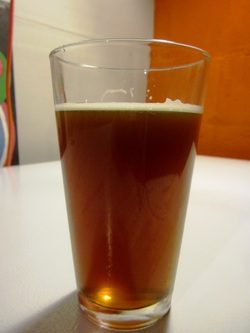 Aroma: No esters, no hops, no caramel. Just straight up Munich and Vienna malt aroma. Appearance: A deep, orangish red hue with a slightly off white head. Head retention could be better but nice clarity and color. Flavor: A bit of a malt bomb upfront with the combo of triple decocted Pilsner, Munich and Vienna but finishes fairly dry. There are some hints of alcoholic warmth which are mostly hidden with heavy malt flavor and the spiciness from the hops. Mouthfeel: Medium bodied, well carbonated and smooth. Could have a little more body but due to decoction mashing the wort was extremely fermentable leaving little residue sugar behind. Overall impression: Good! I like it quite a bit but that may just be the work I put into the decoction mash talking. I don’t drink a ton of German beer so this is far from my specialty but this is going down pretty easily for a 6.5% brew. Definitely smooth and rich but with more spiciness than I would have thought from just the one flavor addition I did. Next time I will have to make sure to figure in the added efficiency for the decoction because I clearly overshot my target leading to the Imperial Festivus naming of the beer. I don’t know, I may bottle this one up just for fun and send off a couple for competition. One last thing. It should be mentioned that this beer was fermented warm using a giant Bohemian Lager yeast starter. As seen in the Brewing TV episode Lager Workarounds studies at Wyeast have shown that this strand can ferment well at 60-65*F while maintaining lager characteristics. While I have access to a fermentation chamber now, I did not when this was brewed so this was my test run of this yeast and I think it turned out pretty well. No obvious flaws so give it a try. Decoction Posting: http://inhousebrew.weebly.com/1/post/2012/08/thoughts-on-decoction-mashing.htmlRecipe: http://inhousebrew.weebly.com/imperialist-festivalist.html
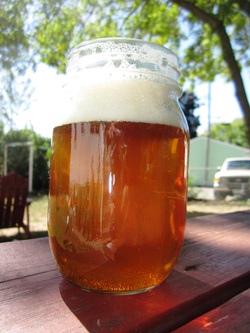 Like many American craft brew lovers I’m a big fan of hops. That said I’m not such a fan of only being able to drink a few of my favorite hoppy beers because of the alcohol content. Now of course I love a good IIPA but now that it is football season I like to sit back and have a handful of beers so I decided one of my brewing goals will be to create a low gravity, hoppy Pale Ale. Basically an American session beer. Working off of my previous Galaxy Pale Ale recipe I’ve tweaked a few things resulting in this: 5 lbs 4.0 oz Rahr 2-Row Pale (1.7 SRM) 58.3 % 2 lbs 12.0 oz Vienna Malt (3.5 SRM) 30.6 % 12.0 oz Caravienne Malt (22.0 SRM) 8.3 % 4.0 oz Biscuit Malt (23.0 SRM) 2.8 % 0.50 oz Cascade [5.50 %] - Boil 60.0 min 10.7 IBUs 0.50 oz Cascade [5.50 %] - Boil 15.0 min 5.3 IBUs 0.50 oz Galaxy [14.00 %] - Boil 10.0 min 9.9 IBUs 0.50 oz Cascade [5.50 %] - Boil 5.0 min 2.1 IBUs 0.50 oz Galaxy [14.00 %] - Boil 5.0 min 5.4 IBUs 1.0 pkg American Ale II (Wyeast Labs #1272) [124.21 ml] 1.00 oz Galaxy [14.00 %] - Dry Hop 7.0 Days 0.50 oz Cascade [5.50 %] - Dry Hop 7.0 Days Thanks to the help of a brewing forum I recently decided I should try to stir more aggressivly when batch sparging so after draining the first runnings and mixing in the 180* water I vigorously stirred for two minutes. Low and behold my pre-boil gravity was almost ten points higher than anticipated and when everything was all said and done I overshot my final gravity by eight points upping my overall brewhouse efficiency from 72% to about 80%. So much for an Americanized session beer though as this tipped me over 5% ABV. Yet another new trick I tried on this brewday was whirlpooling my wort before chilling. The first thing I needed to do was rig up a copper diptube in place of the bazooka screen I had been using to keep hops out of the plate chiller. Easy enough process once the right tools were found. Next step was testing out the whirlpool action so I stirred my wort with a large sanitized spoon and let it sit for 10-15 minutes. I’ll admit the chilling process was a bit nerve racking as I was just waiting for the plate chiller to clog but everything went smoothly and I ended up with a nice little pile of hops in the middle of the pot with very little wort left behind. So, all in all a nice brewday. I learned a few things which I don’t know why I hadn’t tried yet but better late than never right? Also, I ended up with potentially a pretty nice Pale Ale that I may or may not end up scaling back to hit somewhere between 4-4.5% ABV.
 This was the best picture I got although I was alble to suck a little more wort out of this guy before all was said and done.
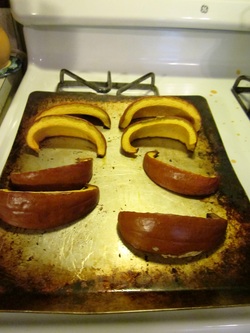 So I finally got around to brewing my Pumpkin Brown Ale recipe that I developed and detailed in Part One and Part Two about a month ago. There were a few last minute changes I made to my recipe and the process. Based on Northern Brewer’s video detailing how to add a pumpkin to your mash I changed up my methodology and instead of roasting the pumpkin in chunks and adding it to the mash as is I roasted it in quarters, pealed the skin off, smashed it up, added it to some hot water and then dumped it in the mash. Overall, a pretty easy process and the kitchen smelled wonderful. I’d say everything went really smoothly which could be due partly to the fact that I did a three gallon BIAB batch so I didn’t need to worry about sparging which I have repeatedly seen people online complaining about. So, having avoided that mess I pretty much nailed this one right on the head. I added two pounds of pumpkin for a 3 gallon batch which went off without a hitch and the pumpkin spices I added in the last five minutes smelled excellent the second I dropped them in. Guess we got a ways to go before any tasting notes come through but the hydrometer sample tasted just like I would want it too; pretty much a English style Brown Ale with a hint of pumpkin spice. This started off as a project for the girlfriend but now that it’s bubbling away I’m honestly pretty curious about this beer so I’m anticipating the day it is ready to be sampled cold and carbonated. Marris Otter (3 SRM) 76.9% C-80 (80SRM) 15.4% Amber Malt (22 SRM) 3.8% Briess Organic Chocolate Malt (350 SRM)3.8 Two Pounds of Pumpkin in the mash 60 minutes: 16.5 IBUsEast Kent Goldings 10 minutes: 6 IBUs East Kent Goldings 5minutes: 1/2ts cinnamon, 1/4ts ginger, 1/8 teaspoon nutmeg, 1/8 ts clove
British Ale Wyeast 1098
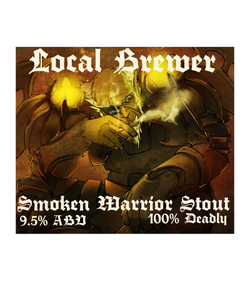 So, I started feeling bad about my big bottled beers after the death of the Kazakhstani Imperial Stout so on a whim tonight I decided to pop open a bottle of my nine month old Smokin’ Warrior Stout and man is it good! This whole batch was a bit of a test run in many regards. First off, it was one of the first stovetop BIAB batches I did so I really had no idea what was going on. Secondly, I had never used Briess Cherrywood Smoked Malt, their new Midnight Wheat or done an all grain Imperial stout so I decided to toss each into this small 1.5 gallon test run of big beer for fun. Because I was embarking on an experimental journey I decided on the Warrior hops I don’t believe I had used before which gave me the obvious benefit of an awesome, recipe appropriate name for the beer; the Smokin’ Warrior Stout. On top of that, when I Google image searched smoking warrior this picture came up and I stole it and made an awesome label.
Overall impressions, this beer is not for everyone. It’s a sipper at 9.5% ABV and in all honesty should have been more but it only attenuated to about 70% leaving the beer sweet, full bodied and awesome for an Imperial Stout. The smoked malt comes in at just the right level and while my girlfriend equated it to licking a burnt log I thought it was pretty damn tasty. All in all, after nine months I think the smoked malt, the residual sweetness and the hop bitterness have balanced out into something pretty good. Maybe worth a slightly larger batch next time. Next time I might swap in some MO in place of whatever I got for Pale Malt and would probably drop the brown sugar down a bit. Of course, I’m writing this after the glass so it’s all based on memory which is skewed from a 9.5% beer and a couple PBRs.
I re-added this beer to my Beersmith files (after I lost everything on my computer crash….) and adjusted it to five gallons just in case I start feeling frisky. Let me
know if anyone has brewed anything similar.
Ingredients
11 lbs 12.0 oz Pale Malt (2 Row) US (2.0 SRM)
Grain 1 56.0 %
4 lbs Briess Cherrywood Smoked Malt (4.0 SRM) Grain 2 19.0 %
1 lbs 12.0 oz Briess Midnight Wheat (550.0 SRM) Grain 3 8.3 %
12.0 oz Cara-Pils/Dextrine (2.0 SRM) Grain 4 3.6 %
12.0 oz Chocolate Malt (450.0 SRM) Grain 5 3.6 %
2 lbs Brown Sugar, Light (8.0 SRM) Sugar 6 9.5 %
2.00 oz Warrior [15.00 %] - Boil 60.0 min Hop 7 70.8 IBUs
American Ale II (Wyeast Labs #1272) [124.21 ml] Yeast
Est Original Gravity: 1.112 SG
Est Final Gravity: 1.021 SG
Estimated Alcohol by Vol: 12.3 %
Bitterness: 70.8 IBUs
Est Color: 65.3 SRM
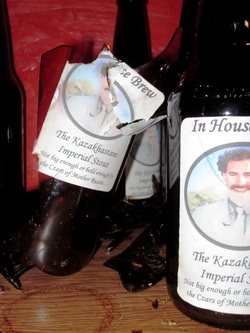 So first off let’s discuss the name because I loved it. This was supposed to be a test batch of a Russian Imperial Stout however somewhere along the line I messed up on a few fronts. It was supposed to be 1.089 but due to this being my first big beer on the stove top BIAB system I undershot and wound up at 1.074. Then there was the color. It was dark but not as black as I would have liked it to have been. So therefore, with the low ABV% and the lacking depth of darkness a friend of mine decided it was not a brew fit for the Czars of Russia so we named it the Kazakhstani Imperial Stout. Added bonus, this also allowed for me to put Borat on the label. After tasting it at a month in the bottles I’d say it was pretty well on its way to becoming a passable Stout.
But (because there’s always a but) it didn’t ferment out properly. My notes indicate it finished fermenting very quickly and only reached a 70% attenuation finishing at 1.025 after three weeks. I wish I could say how much priming sugar I added but my computer crashed and I lost all of my files to Beersmith and didn’t write it down on my paper copy of the recipe. So, we’ll just have to assume that I added too much based on the high final gravity.
|






 RSS Feed
RSS Feed